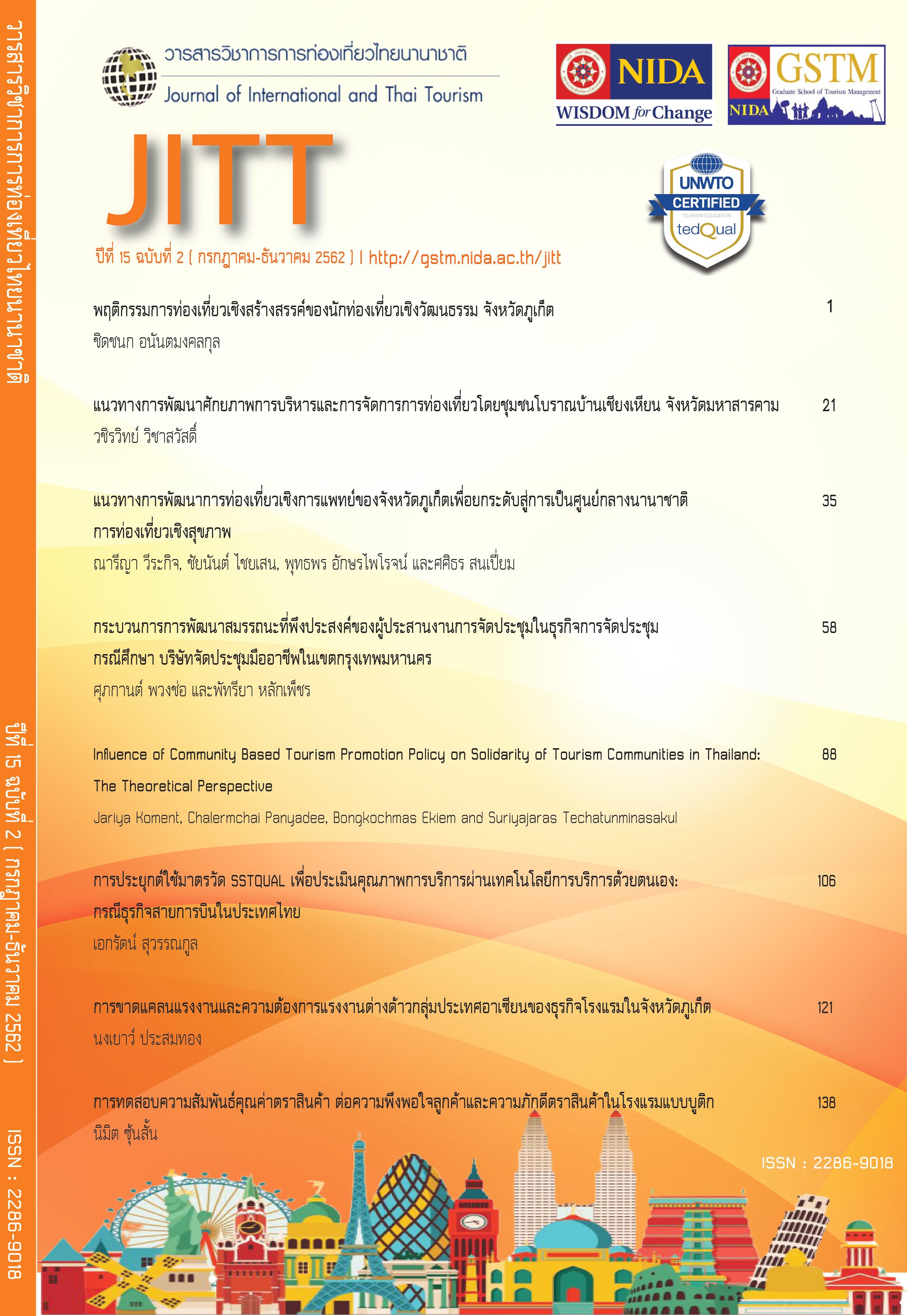การประยุกต์ใช้มาตรวัด SSTQUAL เพื่อประเมินคุณภาพการบริการผ่านเทคโนโลยีการบริการด้วยตนเอง กรณีธุรกิจสายการบินในประเทศไทย
Main Article Content
บทคัดย่อ
บทความวิชาการนี้มีวัตถุประสงค์เพื่อศึกษาแนวทางการวัดระดับคุณภาพการบริการของเทคโนโลยีการบริการด้วยตนเอง (self-service technology) โดยเน้นในบริบทสายการบิน ซึ่งเทคโนโลยีดังกล่าว เป็นช่องทางอิเล็กทรอนิกส์ที่สายการบินนำมาให้บริการลูกค้าผ่านทางเว็บไซต์ โมบายแอปพลิเคชันและ
ตู้บริการอัตโนมัติ เพื่อให้ลูกค้าได้ใช้บริการและดำเนินการกิจกรรมต่าง ๆ ด้วยตนเอง การศึกษาพบว่าการวัดคุณภาพของรูปแบบการบริการที่มีเทคโนโลยีมาเกี่ยวข้อง ควรใช้มาตรวัดที่มีความเหมาะสมโดยเฉพาะ ซึ่งมาตรวัดที่นิยมใช้ปัจจุบัน อาทิ SERVQUAL อาจไม่เหมาะสมที่จะใช้ประเมินคุณภาพการบริการในทุกรูปแบบ โดยเฉพาะการบริการที่ไม่มีการปฏิสัมพันธ์กับพนักงานบริการ
บทความนี้ได้เสนอมาตรวัดที่เรียกว่า มาตรวัด SSTQUAL ซึ่งถูกพัฒนาขึ้นเพื่อใช้วัดคุณภาพ
การให้บริการแบบอิเล็กทรอนิกส์ โดยผ่านการทดสอบความเที่ยงและความถูกต้องของสเกลการวัดและสามารถใช้วัดคุณภาพการบริการผ่านเทคโนโลยีการบริการด้วยตนเองได้ในหลายบริบทภายใต้สภาพแวดล้อมปัจจุบัน มาตรวัด SSTQUAL ประกอบด้วย 7 ด้าน คือ ฟังชั่นการใช้งาน (functionality) ความเพลิดเพลิน (enjoyment) ความปลอดภัย/ความเป็นส่วนตัว (security/privacy) ความเชื่อมั่น (assurance) ดีไซน์ (design) ความสะดวก (convenience) และการปรับแต่งได้ (customization) ส่วนท้ายของบทความนี้ชี้ให้เห็นว่าในบริบทสายการบินในประเทศไทยยังไม่พบว่ามีงานวิจัยนำมาตรวัด SSTQUAL มาใช้ประเมินคุณภาพการบริการผ่านเทคโนโลยีบริการด้วยตัวเองแต่อย่างใด
Article Details
เอกสารอ้างอิง
Alotaibi, M. M. (2015). Evaluation of “AIRQUAL” scale for measuring airlines service quality and its effect on customer satisfaction and loyalty.
Asia Aviation. (2019). Annual Report 2019. Retrieved June 29, 2019 from https://aav.listedcompany.com/misc/AR/20190322-aav-ar2018-en-02.pdf
Bangkok Airways. (2019). Annual Report 2018. Retrieved June 29, 2019 from https://ba.listedcompany.com/misc/ar/20190318-ba-ar2018-en.pdf
Castillo-Manzano, J. I., & López-Valpuesta, L. (2013). Check-in services and passenger behaviour: Self service technologies in airport systems. Computers in Human Behavior, 29(6), 2431-2437.
Chang, H.-L., & Yang, C.-H. (2008). Do airline self-service check-in kiosks meet the needs of passengers? Tourism Management, 29(5), 980-993.
Choi, J.-H., & Park, J.-W. (2014). Investigating the factors influencing the usage of smart entry service: Incheon International Airport case study. International Business Research, 7(1), 74.
Considine, E., & Cormican, K. (2016). Self-service Technology Adoption: An Analysis of Customer to Technology Interactions. Procedia Computer Science, 100, 103-109.
Considine, E., & Cormican, K. (2017). The rise of the prosumer: An analysis of self-service technology adoption in a corporate context. SciKA-Association for Promotion and Dissemination of Scientific Knowledge, 5(2), 25-39.
Cronin Jr, J. J., & Taylor, S. A. (1992). Measuring service quality: a reexamination and extension. The journal of marketing, 55-68.
Curran, J. M., Meuter, M. L., & Surprenant, C. F. (2003). Intentions to use self-service technologies: a confluence of multiple attitudes. Journal of Service Research, 5(3), 209-224.
Dabholkar, P. A. (1996). Consumer evaluations of new technology-based self-service options: an investigation of alternative models of service quality. International Journal of research in Marketing, 13(1), 29-51.
Ekiz, H., Hussain, K., & Bavik, A. (2006). Perceptions of service quality in North Cyprus national airline. Tourism and Hospitality Industry, 3-5.
Hanke, M. (2016). Airline e-Commerce: Log on. Take off: Routledge.
IATA. (2015). Fast Travel Program Strategy. Retrieved April 20, 2019 from https://www.iata.org/whatwedo/passenger/fast-travel/Documents/Fast-Travel-Program-Strategy-V7.pdf
IATA. (2016). 2016 GLOBAL PASSENGER SURVEY. Retrieved April 20, 2019 from https://www.iata.org/publications/store/Documents/GPS-2016-Highlights-Final.pdf
Kho, C. C. (2017). STUDI KUANTITATIF PENGARUH SELF-SERVICE TECHNOLOGY QUALITY (SSTQUAL) TERHADAP KEPUASAN DAN LOYALITAS MAHASISWA PADA FASILITAS INPUT ONLINE DI FAKULTAS BISNIS DAN EKONOMIKA UNIVERSITAS SURABAYA. CALYPTRA, 6(2), 675–690-675–690.
Kumar, R., & Mittal, A. (2015). Customer Satisfaction and Service Quality Perception of Technology based-Banking Services: A Study on Selected Public Sector Banks in India. Global Journal of Management And Business Research.
Lin, J.-S. C., & Hsieh, P.-L. (2011). Assessing the self-service technology encounters: development and validation of SSTQUAL scale. Journal of Retailing, 87(2), 194-206.
Mango, W., Muceldili, B., & Erdil, O. (2017). AN INVESTIGATION OF SELF-SERVICE TECHNOLOGY (SST) OF PARTICIPATION BANKING IN TURKEY. Journal of Economics Finance and Accounting, 4(2), 145-153.
Meuter, M. L., Ostrom, A. L., Bitner, M. J., & Roundtree, R. (2003). The influence of technology anxiety on consumer use and experiences with self-service technologies. Journal of Business Research, 56(11), 899-906.
Meuter, M. L., Ostrom, A. L., Roundtree, R. I., & Bitner, M. J. (2000). Self-service technologies: understanding customer satisfaction with technology-based service encounters. Journal of marketing, 64(3), 50-64.
Nok Air. (2019). Annual Report 2018. Retrieved June 29, 2019 from https://nok.listedcompany.com/misc/AR/20190410-nok-ar2018-en-02.pdf
Oh, H., Jeong, M., & Baloglu, S. (2013). Tourists' adoption of self-service technologies at resort hotels. Journal of Business Research, 66(6), 692-699.
Orel, F. D., & Kara, A. (2014). Supermarket self-checkout service quality, customer satisfaction, and loyalty: Empirical evidence from an emerging market. Journal of Retailing and Consumer Services, 21(2), 118-129.
Parasuraman, A., Zeithaml, V. A., & Berry, L. L. (1988). Servqual: A multiple-item scale for measuring consumer perc. Journal of Retailing, 64(1), 12.
Radomir, L., & Nistor, C. V. (2012). High-educated consumer perceptions of service quality: an assessment of the SSTQUAL scale in the Romanian banking industry. Procedia Economics and Finance, 3, 858-864.
Shin C., & Lee H. (2012). A Study on Airlines' Self-Service Technology(SST) Quality affecting Customer Satisfaction and Behavioral Intention. Tourism Management Research, 51, 97-117.
Singh, A. (2018). Evaluating Passengers’ Perceived Service Quality Towards Self-Service Luggage Check-In Technologies at Airports Using SSTQUAL Scale. Arizona State University,
SITA. (2017). 2017 Passenger IT Trends. Retrieved January 20, 2019 from https://www.sita.aero/globalassets/docs/infographics/2017-passenger-it-trends-infographic.pdf
Thai Airways. (2019). Annual Report 2018. Retrieved June 29, 2019 from https://thai.listedcompany.com/misc/ar/20190409-thai-ar2018-en.pdf
Thai Lion Air. (2019). Start | Check In. Retrieved June 29, 2019 from https://www.lionairthai.com/en/Flight/Web-Checkin
Zeithaml, V. A., Bitner, M. J., & Gremler, D. D. (2009). Services marketing : integrating customer focus across the firm (5th ed.). Boston: Boston : McGraw-Hill Irwin.


